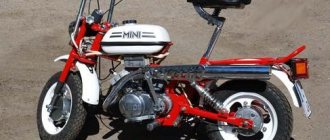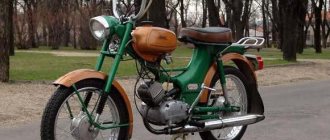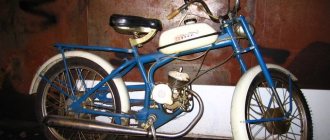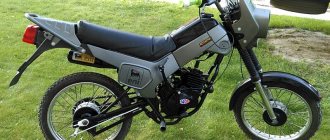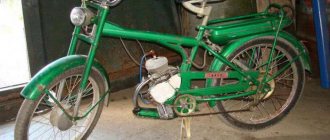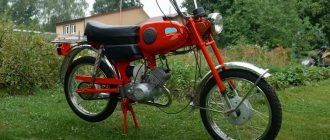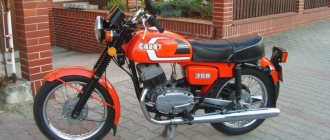It was a revolutionary idea: to make a small, lightweight moped. The strange thing about this idea is that all over the world such a moped was made immediately after the war, when the economy was booming and people could already afford something more expensive than a bicycle. In the Soviet Union, these times came in 1982. Well, or people are simply desperate to wait. Although, like all consumer goods, mokik was produced not because of demand, but because of a plan. The Riga plant had previously produced bicycles with motors, proudly called mopeds, but Riga 26, due to its unusual design or compactness, surpassed all previous versions in terms of the number of mopeds sold.
Minimokic Riga 26
History of the moped Riga 26
In any case, with its technical parameters, the moped allowed some autonomy and independence. Weight is about fifty kilograms, folding steering wheel and seat made it possible to drag the mini mokik for winter storage onto the mini balcony of a mini apartment. Craftsmen sewed a cover and transported the moped to the forest on electric trains. The hefty fuel consumption with an undeveloped gas station system made long trips extreme. Carrying a sufficient supply of gasoline mixture and what you need in the forest (tent, sleeping bag, kayak, pot) is a bit difficult even for such an ant. It has no rear suspension at all, but a conventional front one. The spring fork did not withstand long-term use.
Not children's transport
There is a misconception that the mini prefix means that the item is made for children and children's use. Well, of course, adults move at a different speed. However, in terms of ergonomics, Riga 26 will allow a person of quite decent height to ride. It’s hard to say how much weight the tourists loaded onto this moped. Tested load capacity of at least 150 kilograms. Moreover, it was not necessary to weld the frame after the first trip.
Riga 26 - the first on rural and forest roads
And in the forest he had no equal. Maneuverable and lightweight, the mini mokik Riga 26 allowed you to get into the most berry or mushroom places. The thick rubber of the tires was not so easy to pierce, and once pierced, it was difficult to notice that there was no air in the wheel.
Motor modifications
Riga 26 was equipped at different times with different modifications of the Siauliai plant engine. In factory production, the motor developed a speed of 40 kilometers per hour, but after the first repair, made by smart and knowledgeable hands, the moped already accelerated to over sixty. There were legends that the plant installed Czech engines on some mopeds, but either this was really a legend, or they were sold not far from the factory gates.
In the nineties, the Sarkana Zvaigzne plant was sold piece by piece. This is not to say that it could not withstand competition in a free market. If the equipment had not been looted in a moment of confusion and the space had not been sold off, then there would have been something to present to the public. The experience of craftsmen, lovers of the mini Riga 26 model, would allow us to develop the model range only even on this chassis. A four-stroke engine with a horizontal arrangement, a hydraulic fork and shock absorbers at the rear would make the structure heavier, but would greatly improve the consumer properties.
One of the modifications of the Mokika engine
In 1958, the first moped was produced in (Riga) (then the Verkhovyna moped was made on its basis). The experience was not entirely successful, and the plant designers went to the Czech Jawa
for a detailed acquaintance with the production of small-capacity motor vehicles. After this, in 1960, 10 copies of “Riga-1” were produced and sent for testing. In 50 days, the copies traveled 10,000 km and the following year 5,000 pieces were produced, in 1962 - 27,000, and in 1965 - more than 90,000 pieces.
"Riga-3"
In 1965, the Riga-1 model was discontinued and was replaced by a new model, Riga-3, equipped with a Siauliai-made Sh-51 engine. However, these engines turned out to be not as reliable as Czech ones and the popularity of mopeds waned. Externally, the Riga-3 moped was not very different from its predecessor, except for the modified shape of the tank, a cushion-type seat and a frame with an extended tail section. "Riga-3" turned out to be almost 30% more powerful than "Riga-1", lighter by 2 kg and accelerated to 50 km/h.
"Riga-4"
From 1970 to 1974, Riga-4 was produced. This model was very similar to the Riga-3 and differed only in a small change in the hull lining and the introduction of new technical solutions to the design: the electrical circuit was changed (a high-voltage transformer was added), the design of the guards for the wheels and chains, the design of the gearbox gears, the trunk, installed new wheels of smaller diameter, and the speedometer was driven by the engine.
"Riga-5"
The light moped “Riga-5” began to be produced from 1966 to 1975 and was very different from the predecessors of the “Riga” series and from the “Gauja”, in which not a telescopic fork was used to dampen the front wheel, but compressed springs, allowing the fork to bend forward. The design has also been completely changed. The D-5 series engine without gears, started by pedals, made the moped easier to control, but the dynamics of the moped worsened. "Riga-5" initially had a classic bicycle hub on the rear wheel, providing braking in the same way as a bicycle. But already in 1968, a modification appeared with shoe-type brakes on the rear wheel, and for some time both modifications were produced in parallel, after which shoe brakes completely replaced the bicycle-type rear hub. The frame was also strengthened (the corner bracket was lengthened), because the frames of previous models often cracked when driving on bad roads in the area adjacent to the steering column. With proper engine adjustment, Riga-5 ensured starting from a standstill without the help of pedals and, in exactly the same way, “took” very steep uphill climbs. For example, by starting the engine immediately before an incline of approximately 45°, it was possible to smoothly release the clutch and, without pedal assistance, drive up a slope of any length, provided that the quality of the road surface was not too bad. In addition, for the D-5 and D-6 engines, it was important to very carefully adjust the supply of the fuel mixture so that when idling at maximum speed, the engine would neither stall nor “choke” with fuel. The model was produced until 1971 inclusive, after which it was replaced by the Riga-7 moped.
"Riga-7"
The Riga-7 moped began to be produced in 1969. By the end of 1971, it completely replaced the Riga-5 moped. Unlike the Riga-5, it was equipped with a D-6 engine, which made it possible to connect a headlight and rear marker lamp to it. The decorative protection of the drive chains has been removed. The design of the Riga-7 moped had a special rack installed to prevent frame breakage in cases of emergency braking. Plant workers H. Akermanis (electrician) and J. Bankovich (mechanic) proposed and tested, both on the stand and in practical driving conditions, a frame design with reinforced rear suspension without a rack. The proposal was accepted, royalties were paid within the time limits stipulated by law, but in 1976 the Riga-7 moped was discontinued, replacing it with the Riga-11.
"Riga-11"
“Riga-11” came out as a hybrid of “Riga-7” and, in fact, the basic model “Riga-9”. It was supposed to produce a moped equipped with an engine with an automatic clutch, but after testing, the manufacturer refused to install this engine, changing the design of the moped frame to accommodate the D-6 engine. Wheels of a smaller diameter, but with thicker tires, the original look attracted buyers, but in practice the original look was not in favor of this model. The tank located under the trunk made driving uphill difficult, especially when there was little gas. But the original frame turned out to be fragile.
"Riga-12"
A two-speed moped with a Siauliai engine with bicycle-type pedals, the use of which made it possible to help the engine when overcoming difficult sections of the road, when climbing a mountain, etc. It was produced with different mounting options and shapes of the fuel tank: with an ignition coil on top of the frame under the tank, with a coil ignition from the bottom of the frame under the tank. Visually it differed from the Riga-16 with a short saddle and a smaller trunk.
"Riga-13"
The light moped "Riga-13" replaced the "Riga-11". The moped has been produced since 1983. It was equipped with a 1.3 hp engine. with a maximum speed of 40 km/h. Early models were equipped with a D-8 engine, the most common engines being D-8E, D-8M. Its distinguishing feature is good light and an installed high-voltage transformer, which eliminated frequent problems with the ignition coil. However, the model often failed to ignite: after all, the material of the breaker hammer touching the magnet cam was abraded, which was a typical phenomenon for engines of the “D” series. In “D-6”, in addition, they “modernized” the fastening of the magnetic rotor of the magneto, reducing the knurling depth, as a result of which the magnets often broke off from the central bushing, and the ignition stopped working). This model was produced until 1998. “Riga-13” is the most popular model of the “Riga” mopeds. One of the disadvantages is the frequent breakdown of the clutch cover. "Riga-16"
Moped "Riga-16", engine S-58. In 1977, the two-speed model "Riga-16" was launched into production (there were also experimental models in 1976). It was already a mokick with a kickstarter, a motorcycle-type muffler, a new steering wheel and a tail light. The first Riga-16 models still had the Sh-57 engine; later, one of the most successful Šiauliai engines was installed on the Mokika. This is the first mokick model at RMZ, before that there were only mopeds (that is, with pedals), and this year the first mokick was released at LMZ - “Verkhovina-6”.
"Riga-17S"
Since 1983, the Riga-17S model was launched into production at Riga. Since the Riga Motor Plant does not have its own engine production and corresponding experimental base, VNIImotoprom took over the design and production of the engine for the racing moped, and Sarkana Zvaigen developed the crew part and fine-tuned the machine as a whole. Engine with a volume of 49.8 cubic centimeters and a power of 1.65 hp. allowed the moped to accelerate to 100 km/h.
"Riga-22"
In 1981, the Riga-22 mokik rolled off the assembly line, which became an improved version of the Riga-16 mokik. This model, which accelerated to 50 km/h, was equipped with the Sh-62, Sh-62M, and V-50 engines. These engines were radically different from previous models, primarily in their powerful electronic ignition and gearbox, which necessitated changing the direction of rotation of the crankshaft. The use of electronic non-contact ignition increased the reliability of engine starting and the reliability of the ignition system as a whole. However, “Sh-62” was distinguished by the unreliability of the commutators and gear unit. Therefore, after some time, the engine and switch were modernized, and since 1984 they began to produce mokikis with Sh-62M engines with a power of 1.8 hp. and "V-50" with a new gearbox and a stronger clutch. In addition, the design of the muffler has changed. Despite the modernization, the gearbox still caused trouble for customers. The cross-country model, unified with the Riga-22 moped, was the Riga-20Yu moped, which was equipped with a more sporty frame, a larger diameter front wheel and a foot-operated gear shift - the V-501 motor. It was a small-scale moped intended for training and competitions of young athletes.
"Riga-26" / "Riga-Mini"
In 1982, the mini-mock “Riga-26” (aka “Mini” RMZ-2.126) was developed. This model combined the advantages of a moped and a scooter, was simple and easy to store, and, moreover, did not lose its resemblance to a traditional motorcycle. "Riga-26" took up little space: it could easily fit on the roof or in the trunk of a car, in an elevator, on a balcony or in a utility room of a residential building. However, with a weight of 50 kg, it was very problematic to drag such a mini-mock up the stairs to the balcony or loggia. The wheels of this model were of small diameter (like those of the Vyatka, Tourist, Elektron scooters, however, the tires were smaller (3.00-10). On the first models, the tires were hard, rarely punctured, you could ride on flat wheels. The handlebar handles, if you release the clamping collets, can be turned down in order to put the moped into the car, almost halving the height of the moped. For the same purpose, a device was provided for lowering the saddle, and the seat was also lowered to adjust for height, for children from 6 years. However, certain complaints were made about the handling and maneuverability of the mini-mokick "Riga-26". For example, the tires were so hard that an accidental puncture was simply unnoticeable, and the owner noticed the damage only when inflating the tires. A little later, engines began to be installed on this mokick Czechoslovak production with a horizontal cylinder position, it was a very small batch, much more reliable and worked almost silently, and also had a foot-operated gear switch, “Riga-30” (RMZ 2.130) was distinguished by a spring rear suspension versus the rigid one of 2.126. "Delta" Mokik "Delta"
In 1986, the Delta mokick (RMZ 2.124) was released - this is a continuation of the Riga moped series with a new frame and V-50, V-501, V-501M, V-50M engines. Mokik had modifications “Sport”, “Tourist”, “Lux”. The first releases of the moped were distinguished by a weak frame; later this defect was eliminated. From 1986 to 1989, they were equipped with V-50 and V-501 engines, the trunk handle was chrome-plated, the wings on the glove compartment lids were chrome-plated metal, the round black headlight with a chrome rim, the colors of the moped: red, brown, blue, green . From 1990 to 1996 the trunk was painted in the color of the moped, the wing caps were replaced with black plastic ones, a large square plastic headlight was installed, the latest releases had a small square headlight. They installed a “V-50M”, “V-501M” engine, moped colors: red, blue, beige, white. Also, for an additional fee of 5 rubles, you could purchase additional mirrors to choose from: right or left, or a luggage basket. There were also “Deltas” with cast wheels and a “Dezamet” engine with a three-speed gearbox made in Poland (sold in small quantities in Latvia itself).
"Riga SZ-80"
In 1983, a license for the Simson M531/541 KG-40 engine was purchased from the GDR, and in 1984, the prototype “SZ-81” (an abbreviation for the name) was created on its basis. Like most of the Riga prototypes, it was developed by designer Valdis Kleinbergs and designers Gunars Gludinš and Janis Karklinš. In 1988, the motorcycle, nominally “SZ-80”, was exhibited at the Autodesign’88 exhibition in Moscow. The motorcycle featured improvements that had not previously been seen on mopeds in the USSR: a full-size double seat, cast collapsible wheels, disc brakes, hydraulic shock absorbers, a central Pro-Link monoshock absorber, an estimated speed of above 100 km/h, etc. This minibike was at the level of the best examples of world design and the best in the class of light motorcycles in the USSR, but like most prototypes, it did not go into series. The engine in the 50 cm3 version called “VP-50” was subsequently produced in Vyatskiye Polyany. The motorcycle is in the collection of Alexey Popov and is on display in the permanent exhibition of the Riga Motor Museum.
Closing of production:
The 1990s became a crisis for and the last in its history. After the collapse of the USSR in Latvia, taxes increased, the denationalization of enterprises began, several large deals fell through, in addition, mopeds created competition in the cheapest category, as well as one of the descendants of Gustav Ehrenpreis (the founder of the bicycle factory, on the basis of which Sarkana developed during the Soviet period zweigzne") sued part of the factory territory from the management, and then abandoned the entire enterprise and fled to Europe. Despite all attempts to stay afloat, the production of mopeds and motorcycles was stopped in 1998, and the Riga motorcycle plant with machines, technologies, etc. began to be sold in parts at the price of scrap metal. Now, on the site of this enterprise, as well as in other advanced industries of that time, only old factory ruins remain. But motorcycle lovers remember Riga mopeds and join retro clubs.
Riga 26 today
Although there are still clubs, or even sects of lovers of the Siauliai motor. Checkers can be tuned on the knee. And that's very cool. Technical creativity allows you to improve your overall technical culture. Today you can still find these mopeds in barns and dachas. Restoring a rarity in its original form may be complicated by the fact that the sale of spare parts is not established and will need to be collected from the world piece by piece. Although motors of modern modifications produced by Red October or imported manufacturers will allow you to make a unique toy and put the designer on the move.
Mokik Riga 26, modern tuning
Unfortunately, the sale of these wonderful mopeds is a thing of the past. But, if you set a goal, through the barns, through the bottom of the barrel, you can find crumbs of the past and restore what was unjustly forgotten and disdainfully thrown into the far corner of the garden. It’s hard to believe, but there were years when WLA military Harleys were scrapped, not realizing that their value years later would be much higher than forty kopecks per kilogram. There is confidence that the Riga 26 Mini moped will eventually become as valuable a rarity as the Honda MonkeyZ50 of the first years of production with a similar chassis configuration.
